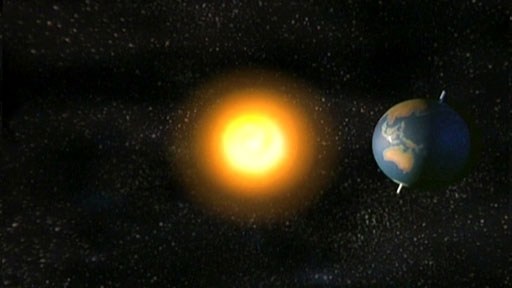Decode the distance from the Earth to the Sun.
The sun is central in our solar system. All solar bodies in the solar system, including planets, meteorites, comets, ., orbit around it. The distance from the Earth to the Sun is called an astronomical unit (AU). An AU unit is currently determined by 149,597,870,700 meters.
According to Space, astronomers used the AU unit to measure every distance in the solar system. For example, Jupiter is 5.2 AU from the Sun while Neptune is 30,07 AU from the center of the Sun. At the outermost edge of the solar system, the Oort cloud, which is believed to be the cradle of comets, is 100,000 AU from the Sun. The distance to the nearest star, Proxima Centauri, is approximately 250,000 AU. However, to measure longer distances, astronomers used the light year or Earth's distance of one year of light travel - equivalent to 63,239 AU. Therefore, Proxima Centauri is converted 4.2 light-years from the Sun.

Elliptical orbit
Astronomical unit (AU) is the average distance from the Earth to the Sun. Every 365.25 days - ie 1 year, the Earth completes a circle around the center of the solar system. However, Earth's orbit is not a perfect circle, but has a more oval or elliptical shape. During the course of a year, the Earth occasionally moves closer to the Sun and sometimes further away. The closest approach of the Earth to the Sun is called the near-daily point, which took place in early January and has a distance of about 146 million kilometers. The time when the Earth was the farthest from the Sun, about 152 million kilometers, was called a far-sighted point.
Determine the distance
History recorded, the first to measure the distance from the Earth to the Sun was Aristarchus around 250 BC. By modern times, astronomer Christiaan Huygens calculated the distance from the Earth to the Sun in 1653.
He uses the stages of Venus to search for angles in Venus - Earth - Sun triangle. For example, when Venus appears halfway in the Sun, three celestial bodies form an equilateral triangle seen from Earth. Conjecturing the size of Venus (inadvertently accurate), Huygens was able to determine the distance from Venus to Earth, and when he knew the distance, plus the angles of the triangle, he was able to measure the distance to the Sun. However, because Huygens's method is partly a speculative product and is not entirely based on scientific grounds, he is often not trusted.

Giovanni Cassini had found the distance from Earth to Mars first, then from there
calculate the distance from the Earth to the Sun. (Photo: Astronomy for beginners)
In 1672, Giovanni Cassini used a method that included parallax or angle error, to find the distance to Mars and at the same time calculate the distance to the Sun. He sent a colleague named Jean Richer to French Guiana while he was in Paris. They measured the relative position of Mars with other stars and triangulated these measurements with a known distance between Paris and Guiana. Once they grasp the distance to Mars, they can also calculate the distance to the Sun. Because Cassini's methods are more scientific, he is often trusted.
New equation
With the advent of the spacecraft and radar, humans have had in hand methods to directly measure the distance between the Earth and the Sun. The definition of an astronomical unit (AU) used to be 'the radius of a circular, undisturbed orbit around the Sun of an extremely small, moving particle with an average motion of 0.01720209895 radians per day. (called Gaussian constant) ".
In addition to making things unnecessarily difficult for astronomy professors, the definition is in fact inconsistent with general relativity. Using the old definition, the value of AU will change based on the position of the observer in the solar system. If the observer above Jupiter used the old definition to calculate the distance between the Earth and the Sun, the result would deviate from the calculated figure on Earth about 1,000 meters.
Moreover, Gaussian constants depend on the mass of the Sun, and because the Sun loses mass when emitting energy, the value of AU changes with it.
In August 2012, the International Astronomical Association voted to convert the definition of astronomical units to an old, simpler number: 149,597,870,700 meters. This number is based on the speed of light, a defined distance not related to the mass of the Sun. 1 meter is defined as the distance that light moves in a vacuum environment in 1 / 299,792,458 seconds.
- The correct distance from Earth to the nearest galaxy
- The earth is farther away from the sun
- Mars and the earth come together
- How to measure the distance through the center of the Milky Way?
- The earth is farthest from the sun of the year
- 2012 TC4 asteroid does not collide with the Earth
- What is the distance from the Earth to the Sun?
- Today the planet is farthest away from the sun
- Giant meteors are about to fly through the earth
- Large meteorite by bus has just approached the Earth
- NASA dismisses the information of giant meteorite
- Earth is closer to the black hole than expected
 Van Allen's belt and evidence that the Apollo 11 mission to the Moon was myth
Van Allen's belt and evidence that the Apollo 11 mission to the Moon was myth The levels of civilization in the universe (Kardashev scale)
The levels of civilization in the universe (Kardashev scale) Today Mars, the sun and the Earth are aligned
Today Mars, the sun and the Earth are aligned The Amazon owner announced a secret plan to build a space base for thousands of people
The Amazon owner announced a secret plan to build a space base for thousands of people